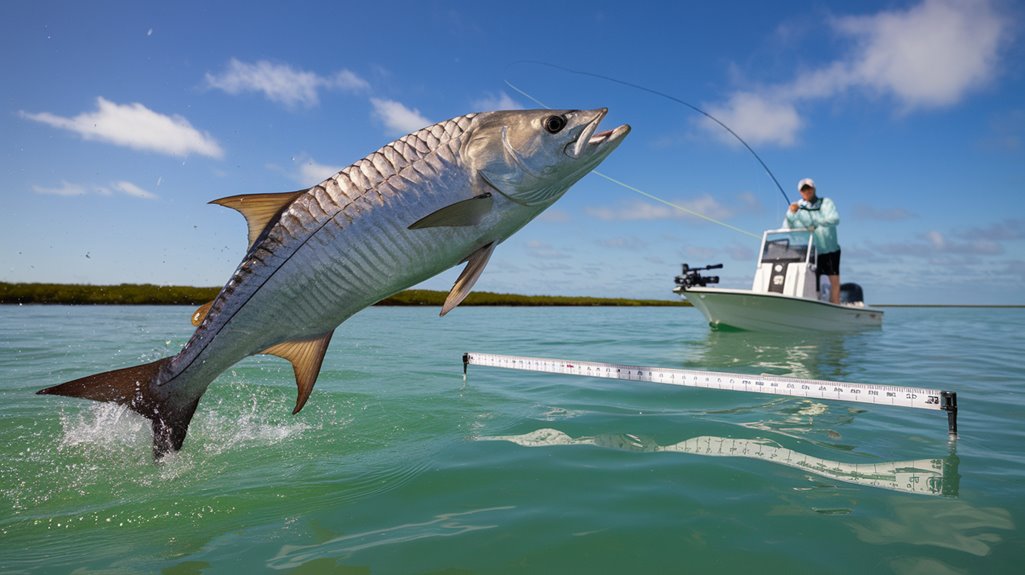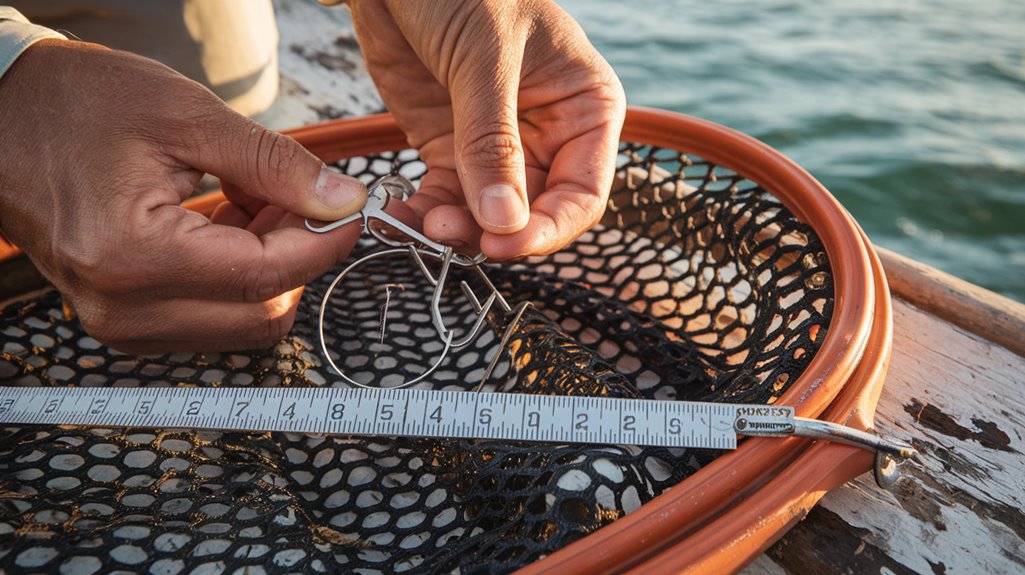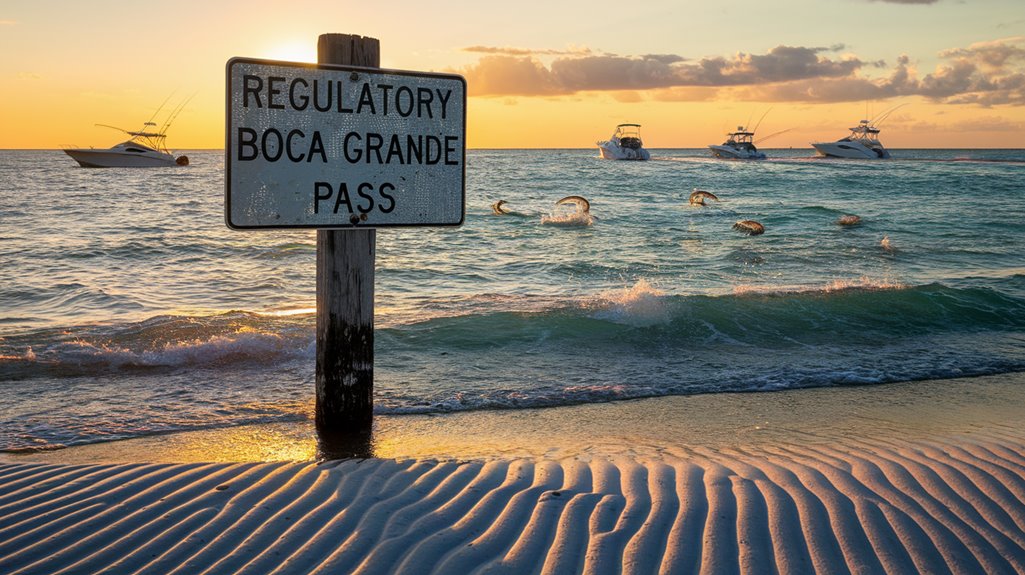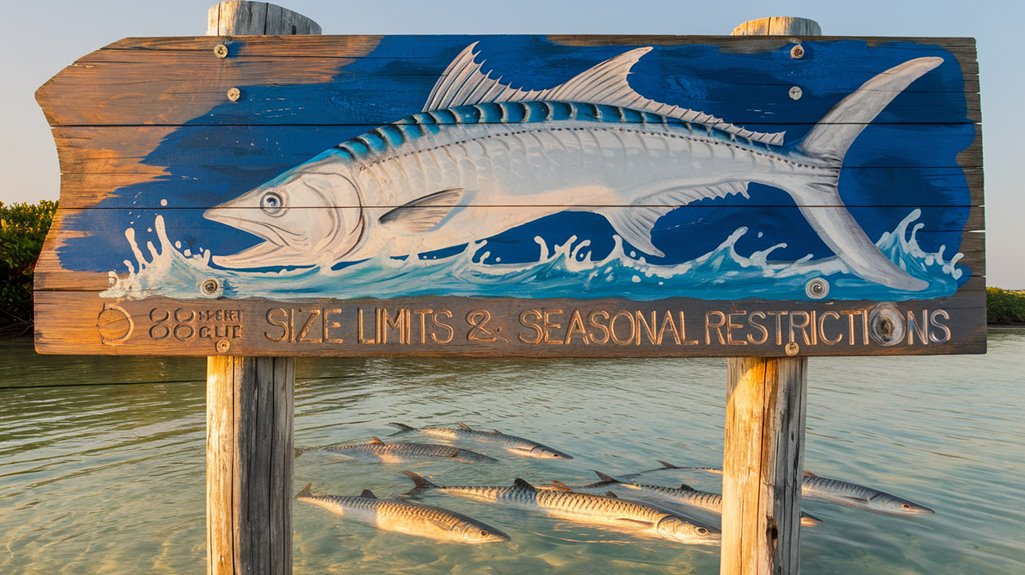You'll need to understand precise regulations when targeting Megalops atlanticus (tarpon) in regulated waters. The species' protected status requires strict adherence to catch-and-release protocols, particularly for specimens exceeding 40 inches in total length. Conservation measures mandate specific gear configurations, including non-offset circle hooks and specialized leader materials. These requirements form just the foundation of a complex regulatory framework that safeguards this prehistoric gamefish.
- Key Takeaways
- Understanding Tarpon Catch and Release Requirements
- Size Limitations and Record Pursuit Guidelines
- Essential Gear Regulations for Tarpon Fishing
- Boca Grande Pass Special Restrictions
- Seasonal Equipment Rules and Limitations
- Best Practices for Tarpon Handling
- Legal Requirements for Tag Applications
- State-Specific Conservation Measures
- Proper Release Techniques and Safety Protocols
- Documentation Requirements for Record Attempts
- Frequently Asked Questions
- Conclusion
Key Takeaways
- Tarpon must be released after capture, with zero-harvest policy enforced to protect the species.
- Fish over 40 inches must remain in water unless angler has obtained a special tarpon tag.
- Only non-stainless, non-offset, barbless circle hooks are permitted when fishing for tarpon.
- Maximum of three active fishing lines per vessel allowed during peak season from April to June.
- Weight configurations must be positioned above hooks, and breakaway gear is prohibited during fishing.
Understanding Tarpon Catch and Release Requirements

While tarpon have captivated anglers for generations, their preservation requires strict adherence to catch-and-release protocols. You'll need to follow specific fishing regulations when targeting these magnificent gamefish, as they're protected by a zero-harvest policy with no minimum size restrictions.
For specimens exceeding 40 inches in length, you must maintain the tarpon in its aquatic environment unless you've obtained a tarpon tag for record attempts. You're limited to one tag annually for such pursuits. To minimize physiological stress during catch and release, you'll need to implement non-stainless, non-offset, barbless circle hooks. These specialized hooks reduce tissue damage and promote survival rates. Additionally, regulations prohibit snagging techniques and mandate minimal handling to protect both individual specimens and their ecological habitat.
Size Limitations and Record Pursuit Guidelines
Although tarpon fishing has no minimum size restrictions, specimens exceeding 40 inches must remain in their aquatic environment unless you've secured a tarpon tag for record attempts. The Florida Fish and Wildlife Commission issues one tarpon tag annually per angler specifically for pursuing record catches.
If you're targeting record-breaking specimens, you'll need to know the current benchmarks. Florida's state record stands at 243 pounds, established by Gus Bell in 1975, while the all-tackle world record reaches 286 pounds, 9 ounces, set by Max Domecq in 2003. To verify current world record specifications, you'll want to consult the International Game Fish Association's official database. This guarantees you're working with the most up-to-date metrics when pursuing potential record-breaking catches.
Essential Gear Regulations for Tarpon Fishing

To maintain compliance with tarpon fishing regulations, you'll need to equip your tackle with non-stainless, non-offset, barbless circle hooks when using bait presentations. Your gear configuration must follow strict guidelines regarding weight placement, specifically ensuring weights don't extend below hook position when suspended in Boca Grande Pass. You must limit your vessel to three active fishing lines during peak season (April-June), while maintaining all required gear in proper storage conditions that facilitate quick access for inspection.
Legal Hook Setup Requirements
Since tarpon are protected game fish, anglers must adhere to strict hook setup requirements that prioritize the species' conservation. You'll need to equip your tackle with non-stainless, non-offset, barbless circle hooks to minimize tissue damage during catch and release operations. When fishing in Boca Grande Pass, verify any weight configurations don't extend below the hook point when the line is vertical. You're limited to three fishing lines per vessel during peak season (April-June), and all tackle must comply with breakaway gear prohibitions. If you're pursuing record catches, you'll need to obtain a tarpon tag, which permits retention of one specimen annually. Multiple hooks paired with natural bait are prohibited, and any non-compliant gear must remain properly stowed while onboard.
Approved Weight Configurations Only
Weight configuration regulations represent a critical component of legal tarpon fishing gear, particularly in Boca Grande Pass. You'll need to guarantee your weight setup complies with the specific requirement that no gear with weight hangs below the hook when your line is suspended vertically in the water column.
To maximize catch-and-release success while adhering to approved weight configurations, you'll want to pair your setup with non-stainless, non-offset, barbless circle hooks. When fishing during peak tarpon season from April through June, you're limited to three fishing lines per vessel. Remember that you must properly stow any non-compliant gear configurations while on board. These fishing regulations strictly prohibit breakaway gear and multiple-hook setups with natural bait to protect the tarpon population.
Proper Equipment Storage Rules
While traversing Boca Grande Pass waters, you'll need to properly stow any non-compliant fishing gear aboard your vessel to meet regulatory requirements. During tarpon season, you must make sure that weighted gear configurations don't allow weights to hang below the hook position when suspended vertically.
When fishing for tarpon, you're restricted to hook-and-line methods exclusively, as regulations prohibit snagging, snatch hooking, and spearing techniques. During peak season (April through June), you must limit your active fishing lines to three per vessel to maintain sustainable harvesting practices. Additionally, breakaway gear configurations are strictly prohibited during this period to support effective catch-and-release protocols. Proper equipment storage not only guarantees regulatory compliance but also helps preserve the integrity of tarpon fishing in these waters.
Boca Grande Pass Special Restrictions

You'll need to guarantee your gear configuration in Boca Grande Pass keeps all weights positioned above the hook while suspended, with natural bait being the only permissible component below the hook point. During peak tarpon season (April-June), you must avoid using breakaway gear and sliding-weight jigs to protect the fishery. You're required to properly stow any non-compliant equipment while on board your vessel in the Pass to maintain regulatory compliance.
Weight Below Hook Rules
Special regulations in Boca Grande Pass strictly govern the placement of weights in relation to fishing hooks, establishing precise vertical alignment requirements for all tackle configurations. You'll need to verify your weights don't hang lower than the hook when suspended, as this configuration constitutes illegal gear. If you're carrying non-compliant tackle through the Pass, you must properly stow it.
During peak tarpon season (April through June), conservation efforts are heightened, and you're prohibited from using breakaway gear. You also can't use jigs designed with weights that slide down the shank. These regulations serve a critical purpose in protecting the local tarpon population. By maintaining proper weight positioning above or level with hooks, you're contributing to sustainable fishing practices that preserve the Pass's unique ecosystem.
Stowing Illegal Equipment
Proper stowage of non-compliant fishing equipment stands as a fundamental requirement when steering through Boca Grande Pass. You'll need to verify any prohibited gear remains securely stowed while traversing these regulated waters. While natural bait isn't classified as a weight under local ordinances, you must properly store any tackle featuring weights positioned below hooks or breakaway components.
| Equipment Type | Storage Requirement | Compliance Status |
|---|---|---|
| Sliding Jigs | Must be stowed | Prohibited |
| Natural Bait | Can remain accessible | Permitted |
| Weight-below-hook | Must be stowed | Prohibited |
During peak tarpon season (April-June), you're restricted to three fishing lines maximum. This regulation applies even if you're carrying additional equipment that's properly stowed. Verifying your gear configuration aligns with these specifications helps maintain the ecological balance while preventing enforcement issues.
Seasonal Line Limitations
During peak tarpon season in Boca Grande Pass, vessels must adhere to a strict three-line maximum restriction from April through June. This regulation guarantees effective management of the tarpon fishery while maintaining sustainable catch rates in the pass.
You'll need to comply with additional equipment regulations during this period. Your fishing gear must feature weights positioned above the hooks when suspended, and you can't use any breakaway gear or jigs that allow weights to slip down the shank. If you're carrying any prohibited equipment while in Boca Grande Pass, you must properly stow it aboard your vessel. These extensive fishing regulations protect the tarpon population while promoting responsible angling practices in one of Florida's premier fishing destinations.
Seasonal Equipment Rules and Limitations
Strict equipment regulations govern tarpon fishing in Boca Grande Pass, with vessels restricted to a maximum of three fishing lines from April through June. During this peak season, you'll need to guarantee your gear configuration complies with specific requirements. Any weighted equipment that hangs below the hook must be stowed while in the pass, and breakaway gear is strictly prohibited during the spring months.
Florida's regulations mandate catch-and-release only practices for tarpon, with just one tarpon tag per person annually for record attempts. When handling these magnificent game fish, you must keep all specimens over 40 inches submerged unless you're pursuing a state or world record. These equipment and handling protocols help preserve the fishery's sustainability while maintaining fair sporting practices.
Best Practices for Tarpon Handling
Successful tarpon release practices hinge on five essential handling protocols that maximize survival rates. When handling tarpon under 40 inches, you'll need to use wet hands to preserve their protective slime coating. For specimens exceeding 40 inches, maintain their position in the water throughout the release process. Support the fish horizontally during any necessary lifting, avoiding contact with boat gunnels or other hard surfaces that could cause trauma.
Keep a long-handled dehooking device readily accessible to expedite hook removal, minimizing the tarpon's exposure to stress. If you notice signs of lethargy, properly position the fish to allow water flow through the mouth and across the gills until it shows signs of recovery, ensuring ideal oxygenation before release.
Legal Requirements for Tag Applications
You'll need to secure your annual tarpon tag through an official application process, which requires completing Form FWC-123 and submitting current fishing license documentation to your state's wildlife conservation agency. Your application must specify intended pursuit of record catches, as tags are exclusively issued for fish exceeding 40 inches in total length and are limited to one per person annually. To complete your $50 tag purchase, you can submit your documentation through the agency's online portal or at authorized physical locations where officials will verify your credentials and issue the permit.
Tag Application Process
The legal requirements for obtaining a tarpon tag involve multiple prerequisites that anglers must fulfill before pursuing state or world records. You'll need to secure a valid fishing license through your state's Wildlife Conservation Commission before applying for the specialized tarpon tag, which costs approximately $50. This tag is specifically required when you intend to remove a tarpon exceeding 40 inches from the water for record documentation purposes.
You can submit your application through state wildlife agencies or their designated online platforms. When pursuing a state or world record, you're limited to one tarpon tag annually. Remember to accurately measure and weigh your catch, as these measurements are essential for your record application submission. You must also adhere to all catch-and-release protocols while documenting your record attempt.
Documentation and Forms Required
When applying for a tarpon tag, anglers must provide specific documentation that validates their eligibility for record pursuits. You'll need to present valid personal identification along with proof of your current fishing license. The annual saltwater fishing license, which costs $35 for Texas residents, serves as a prerequisite for obtaining the specialized tarpon tag.
The regulations stipulate that you're limited to one tarpon tag per calendar year, priced at approximately $50. You must maintain accurate documentation of both your fishing license and tarpon tag while pursuing state or world records. Be aware that these regulations also govern the transport and shipment protocols, restricting you to a single fish. Compliance with all documentation requirements guarantees your eligibility for record consideration.
Annual Permit Purchase Rules
Legal compliance for tarpon tag applications involves strict adherence to annual permit purchase requirements. You'll need to secure a specialized tarpon tag if you're pursuing record catches, with a limit of one tag per calendar year at a cost of $50. While standard catch-and-release fishing doesn't require a tag, keeping a tarpon necessitates both the tag and an approved permit.
| Requirement | Purpose | Limitation |
|---|---|---|
| Tarpon Tag | Record Pursuit | 1 per year |
| Base Permit | Legal Possession | 1 per angler |
| Release Documentation | Population Monitoring | Per catch |
| Catch Record | Species Management | Daily log |
| Conservation Fee | Resource Protection | Annual |
These fishing regulations guarantee sustainable management of tarpon populations while allowing anglers to participate in record attempts through a structured permitting system.
State-Specific Conservation Measures
State-specific conservation measures for tarpon fishing demonstrate rigorous protocols, particularly in Texas where regulations mandate catch-and-release practices with limited exceptions. You'll need to obtain a tarpon tag if you're pursuing state or world records, with a strict limit of one tag annually. Conservation guidelines require you to keep tarpon over 40 inches in the water unless you're documenting a record catch.
Texas fishing regulations explicitly prohibit techniques that could harm tarpon populations, including snagging, snatch hooking, and using multiple hooks with natural bait. These measures align with other states' conservation efforts to maintain sustainable tarpon populations. Your participation in sharing fishing experiences contributes to community awareness and supports ongoing conservation initiatives that protect this valuable species.
Proper Release Techniques and Safety Protocols
Proper release techniques for tarpon require meticulous attention to established safety protocols that protect both the angler and fish. You'll need to maintain specimens over 40 inches submerged while handling, and utilize wet hands for smaller specimens to minimize epidermal damage. Release procedures demand efficient dehooking methodology using specialized long-handled tools.
| Protocol | Method | Duration |
|---|---|---|
| Large Tarpon | Keep Submerged | Entire Process |
| Small Tarpon | Wet Hands | Brief Contact |
| Hook Removal | Long Tools | <30 Seconds |
| Revival | Oxygenated Flow | Until Active |
| Documentation | Underwater Photos | Quick Capture |
For post-release survival, you'll need to facilitate proper oxygenation by positioning the tarpon facing into the current, allowing water to flow through their buccal cavity and across the gill filaments until they demonstrate sufficient swimming capability.
Documentation Requirements for Record Attempts
When pursuing a record tarpon certification, you'll need to secure a regulated tarpon tag and adhere to IGFA's stringent documentation protocols. You're limited to one tag annually, making each record attempt particularly significant.
For proper documentation, you must maintain the tarpon's position in the water, especially for specimens exceeding 40 inches. You'll need to record precise measurements, including total length and girth circumference, while minimizing the fish's time out of water. Your submission to IGFA or state authorities must include thorough photographic evidence of your catch, depicting clear measurement readings and proper handling techniques.
You'll need to verify that all gear and methods comply with regulatory standards, as any deviation from prescribed protocols will invalidate your record attempt. Maintain detailed records of all documentation requirements throughout the process.
Frequently Asked Questions
What Are the Rules for Tarpon Fishing in Florida?
You'll need to practice catch-and-release for tarpon, keep specimens over 40 inches in water, and use only hook-and-line gear. During peak season, you're limited to three lines per vessel.
Are You Allowed to Keep Tarpon in Texas?
You can't keep tarpon in Texas except with a single annual tag for record attempts. You must release all other tarpon and keep specimens over 40 inches in the water during handling.
Why Is It Illegal to Catch Tarpon in Florida?
You actually can catch tarpon in Florida, but it's regulated as catch-and-release only to maintain population sustainability. You're limited to one harvest annually, strictly for record-seeking purposes with proper tags.
How Far Offshore Are Tarpon?
You'll find tarpon from nearshore waters to approximately 100 feet offshore, with peak concentrations around coastal structures. They'll migrate deeper during summer months, frequently inhabiting depths between 30-60 feet.
Conclusion
You'll need to maintain compliance with all regulatory parameters when targeting Megalops atlanticus. Guarantee your terminal tackle meets the non-offset circle hook requirements (≤5° deviation) and verify your non-stainless steel components. You must keep specimens >40 inches submerged unless you've secured the requisite harvest tag. Remember to document length measurements, hook placement, and release times for proper data submission to conservation authorities.

